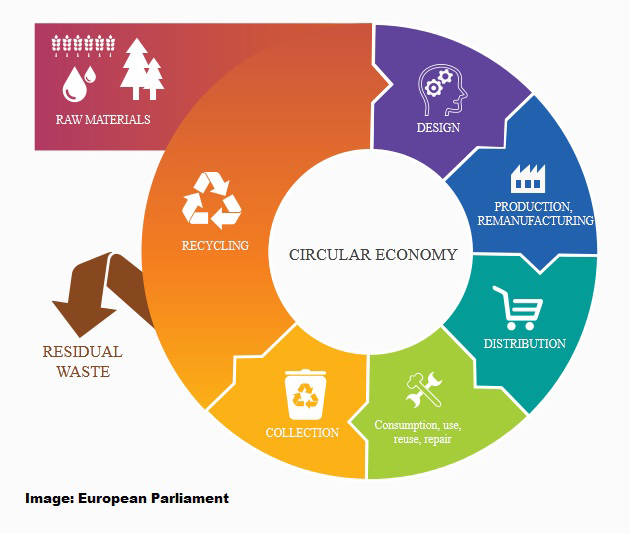Romania’s recycling system is beset by issues. The country has the second lowest rate of recycling in the European Union, at only 3 percent of the 5.8 million tons of waste produced every year, according to the latest report by the European Environment Agency (EEA), exceeding only Bulgaria on 0 percent.
By Aurel Dragan
The EEA report found that 18 of 33 reviewed waste prevention programs have explicit objectives for the reuse of products, but measures to promote reuse are most often voluntary. Only 10 percent of the programs include regulatory measures and 8 percent cite economic instruments. The big picture of the waste hierarchy in the EU is based on five steps: prevention, preparing for reuse, recycling, recovery and disposal. It is like a reversed pyramid, with the latter the least used.
So far, the most prominent method that EU states use is waste management (including recycling), which accounts for 53 percent of the reported national policy approaches to closing material loops. Waste prevention stands at only 17 percent and ‘reuse, repair, redistribute, refurbish and remanufacture’ at 3 percent. The five ’Rs’ are one of the most important parts of the circular economy, meaning different processes through which products are returned to a good condition and brought back into use. There are many people in Romania repairing or reconditioning their products in order to prolong their usage (including the second-hand sale of textiles or other goods, like a program started in Sweden), but the country lacks its own program in this area, so there is no data from Romania.he EEA report found that 18 of 33 reviewed waste prevention programs have explicit objectives for the reuse of products, but measures to promote reuse are most often voluntary. Only 10 percent of the programs include regulatory measures and 8 percent cite economic instruments. The big picture of the waste hierarchy in the EU is based on five steps: prevention, preparing for reuse, recycling, recovery and disposal. It is like a reversed pyramid, with the latter the least used.
Among the common approaches is creating and maintaining a national website incorporating regional information on the location and availability of second-hand construction materials, which is currently used by countries such as Austria, Bulgaria and Greece. Another simpler example of what can be introduced is reduced VAT on repairs, a measure used by several countries including Sweden, Belgium, Poland and Slovenia.
One of the programs in Romania was created by the non-governmental organization (NGO) Ateliere Fara Frontiere, which provides work for formerly unemployable people that includes preparing WEEE (waste of electrical and electronic equipment) for reuse. The refurbished appliances are then donated to schools, kindergartens and other needy institutions.
Private sector steps up
Romania has a waste collection rate of only 82.3 percent, the third lowest in the EU, after Bulgaria with 81 percent and Estonia with 79 percent. Of the total of 5.8 million tons of waste per year, the capital is responsible for 1 million tons, according to City Hall data.
While the country lacks a significant program, the good news is that there are several projects in the making. Bucharest recently saw the launch of the Master Plan of Integrated Waste Management which is meant to introduce the circular economy into waste management.

The mayor of Bucharest, Gabriela Firea, announced that 50 automated waste collection stations will be inaugurated in the six sectors of Bucharest. “We have no time to waste, because we are all aware that only by a joint effort will we be able to reach the target we have set: for 50 percent of waste to be recycled by 2020,” said Firea. Currently, only 10 to 15 percent of waste is recycled. “To reach this target, we need to work together, central authorities, local public authorities and the private sector – which is of particular importance in this area, and investments are extremely necessary and need to be encouraged,” said Firea.
The private sector is already doing its part. Most retailers have introduced measures to use biodegradable packaging or eliminate plastic products. Carrefour was the first to introduce 100 percent biodegradable bags, an innovative national product. Created on that basis by a Romanian producer, the new bags are available in all the retailer’s 320 stores in Romania. Lidl also announced that by the end of 2025 it will reduce the quantity of plastic used by 20 percent. In the first phase, by the end of 2018, the company will give up the use of disposable plastic articles such as glasses, deep and wide dishes, spoons and forks. The measure will be taken in all 225 Lidl stores in the country. A similar measure was announced by Kaufland, which will ensure the 100 percent recyclability of the plastic used for its own brands, and by the end of 2019 it will stop selling certain plastic articles.
And there are examples from smaller firms too. A startup from Cluj, set up by Maria and Lukasz Lichtenberg, has started making biodegradable and edible plates, made of wheat, sugar cane, bamboo or apple. They got the idea from Poland, where the plate was invented and patented, and deliver the dishes to restaurants and festivals all over the country. Another company, Foldo, is delivering furniture and decorative products made from cardboard and other light materials, which are 100 percent biodegradable. And an entrepreneur from Constanta, Ioana Matei, was among the finalists of Young Champions of Earth, organized by the United Nations Organization Environment, with a project taking recycled cooking oil and turning it into an eco-friendly cleaner.
The implementation of a circular economy requires the efforts of all authorities, civil society and citizens. So far, just civil society and some citizens are doing their part.


:quality(80)/business-review.eu/wp-content/uploads/2018/08/foto-economie-circulara-aurel.jpg)

:quality(80)/business-review.eu/wp-content/uploads/2016/12/european-investments-bank.jpg)




:quality(80)/business-review.eu/wp-content/uploads/2024/02/IMG_6951.jpg)

:quality(80)/business-review.eu/wp-content/uploads/2024/04/COVER-1.jpg)



:quality(50)/business-review.eu/wp-content/uploads/2018/08/foto-economie-circulara-aurel.jpg)
:quality(50)/business-review.eu/wp-content/uploads/2024/02/Mihaela-Frasineanu-and-Cristian-Nacu.jpg)
:quality(50)/business-review.eu/wp-content/uploads/2024/01/gov-ifc.jpg)
:quality(80)/business-review.eu/wp-content/uploads/2024/04/cover-april.jpg)
:quality(50)/business-review.eu/wp-content/uploads/2024/04/FOT_9989-7-scaled.jpg)
:quality(50)/business-review.eu/wp-content/uploads/2023/08/One-Floreasca-City-2-scaled.jpg)
:quality(50)/business-review.eu/wp-content/uploads/2024/04/ROMTEXTIL-2.jpg)